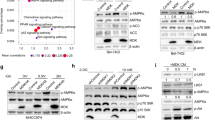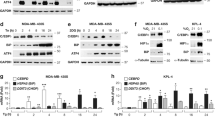Abstract
A number of genes involved in tumorigenesis have been known to be controlled by signal transducer and activator of transcription 3 (STAT3) and NF-κB, either synergistically or individually. In starved cancer cells, we found that NF-κB was activated through endoplasmic reticulum stress signals, which depend on reactive oxygen species, cytosolic calcium and preserved translation of NF-κB p65 subunit, but independent of IκBα serine phosphorylation, thereby resulting in IL6 induction. STAT3 was required for proper induction of IL6 by NF-κB. They existed as identical nuclear complexes in proximal IL6 promoters, and STAT3 had critical roles in binding to IL6 promoters as well as nuclear retention of NF-κB. The conditioned media from starved cancer cells contained various secretory factors, such as IL6, IL9, VWF (von Willebrand factor), FREM1 (FRAS1 related extracellular matrix 1), SAA1 (serum amyloid A1), SDK1 (sidekick homolog 1) and ADAM12 (ADAM metallopeptidase domain 12), induced by NF-κB and STAT3 and promoted clonogenic capacities of cancer cells, and proliferation and migration of human umbilical vein endothelial cells. These results suggest novel survival strategies of cancer cells by which two oncogenic transcriptional factors, NF-κB and STAT3, are activated simultaneously by an intrinsic mechanism during stressful conditions of cancer cells, and they cooperatively induce various survival factors.
This is a preview of subscription content, access via your institution
Access options
Subscribe to this journal
Receive 50 print issues and online access
$259.00 per year
only $5.18 per issue
Buy this article
- Purchase on Springer Link
- Instant access to full article PDF
Prices may be subject to local taxes which are calculated during checkout








Similar content being viewed by others
References
Ba X, Gupta S, Davidson M, Garg NJ . (2010). Trypanosoma cruzi induces the reactive oxygen species-PARP-1-RelA pathway for up-regulation of cytokine expression in cardiomyocytes. J Biol Chem 285: 11596–11606.
Bosco N, Pelliccia F, Rocchi A . (2010). Characterization of FRA7B, a human common fragile site mapped at the 7p chromosome terminal region. Cancer Genet Cytogenet 202: 47–52.
Deng J, Lu PD, Zhang Y, Scheuner D, Kaufman RJ, Sonenberg N et al. (2004). Translational repression mediates activation of nuclear factor kappa B by phosphorylated translation initiation factor 2. Mol Cell Biol 24: 10161–10168.
Frank DA . (2003). STAT signaling in cancer: insights into pathogenesis and treatment strategies. Cancer Treat Res 115: 267–291.
Franken NA, Rodermond HM, Stap J, Haveman J, van Bree C . (2006). Clonogenic assay of cells in vitro. Nat Protoc 1: 2315–2319.
Fujita T, Nolan GP, Ghosh S, Baltimore D . (1992). Independent modes of transcriptional activation by the p50 and p65 subunits of NF-kappa B. Genes Dev 6: 775–787.
Gil-Bazo I, Catalan V, Paramo J, Quero C, Escriva de Romani S, Perez-Ochoa A et al. (2003). Von Willebrand factor as an intermediate between hemostasis and angiogenesis of tumor origin. Rev Med Univ Navarra 47: 22–28.
Gloire G, Charlier E, Rahmouni S, Volanti C, Chariot A, Erneux C et al. (2006). Restoration of SHIP-1 activity in human leukemic cells modifies NF-kappa B activation pathway and cellular survival upon oxidative stress. Oncogene 25: 5485–5494.
Gorlach A, Klappa P, Kietzmann T . (2006). The endoplasmic reticulum: folding, calcium homeostasis, signaling, and redox control. Antioxid Redox Signal 8: 1391–1418.
Goswami R, Kaplan MH . (2011). A brief history of IL-9. J Immunol 186: 3283–3288.
Grivennikov SI, Karin M . (2009). Dangerous liaisons: STAT3 and NF-kappa B collaboration and crosstalk in cancer. Cytokine Growth Factor Rev 21: 11–19.
Groner B, Lucks P, Borghouts C . (2008). The function of Stat3 in tumor cells and their microenvironment. Semin Cell Dev Biol 19: 341–350.
Hoyer-Hansen M, Jaattela M . (2007). Connecting endoplasmic reticulum stress to autophagy by unfolded protein response and calcium. Cell Death Differ 14: 1576–1582.
Hu P, Han Z, Couvillon AD, Kaufman RJ, Exton JH . (2006). Autocrine tumor necrosis factor alpha links endoplasmic reticulum stress to the membrane death receptor pathway through IRE1alpha-mediated NF-kappa B activation and down-regulation of TRAF2 expression. Mol Cell Biol 26: 3071–3084.
Iliopoulos D, Hirsch HA, Struhl K . (2009). An epigenetic switch involving NF-kappa B, Lin28, Let-7 microRNA, and IL6 links inflammation to cell transformation. Cell 139: 693–706.
Jacobsen J, Wewer UM . (2009). Targeting ADAM12 in human disease: head, body or tail? Curr Pharm Des 15: 2300–2310.
Jiang HY, Wek RC . (2005). GCN2 phosphorylation of eIF2 alpha activates NF-kappa B in response to UV irradiation. Biochem J 385 (Pt 2): 371–380.
Kamata H, Honda S, Maeda S, Chang L, Hirata H, Karin M . (2005). Reactive oxygen species promote TNF alpha-induced death and sustained JNK activation by inhibiting MAP kinase phosphatases. Cell 120: 649–661.
Kang MJ, Ryu BK, Lee MG, Han J, Lee JH, Ha TK et al. (2008). NF-kappa B activates transcription of the RNA-binding factor HuR, via PI3K-AKT signaling, to promote gastric tumorigenesis. Gastroenterology 135: 2030–2042 2042 e2031-2033.
Karin M . (2006). NF-kappa B and cancer: mechanisms and targets. Mol Carcinog 45: 355–361.
Karin M, Lin A . (2002). NF-kappa B at the crossroads of life and death. Nat Immunol 3: 221–227.
Khabar KS . (2010). Post-transcriptional control during chronic inflammation and cancer: a focus on AU-rich elements. Cell Mol Life Sci 67: 2937–2955.
Kilberg MS, Shan J, Su N . (2009). ATF4-dependent transcription mediates signaling of amino acid limitation. Trends Endocrinol Metab 20: 436–443.
Kitamura M . (2009). Biphasic, bidirectional regulation of NF-kappa B by endoplasmic reticulum stress. Antioxid Redox Signal 11: 2353–2364.
Lee H, Herrmann A, Deng JH, Kujawski M, Niu G, Li Z et al. (2009). Persistently activated Stat3 maintains constitutive NF-kappa B activity in tumors. Cancer Cell 15: 283–293.
Lee JK, Edderkaoui M, Truong P, Ohno I, Jang KT, Berti A et al. (2007). NADPH oxidase promotes pancreatic cancer cell survival via inhibiting JAK2 dephosphorylation by tyrosine phosphatases. Gastroenterology 133: 1637–1648.
Li J, Ni M, Lee B, Barron E, Hinton DR, Lee AS . (2008). The unfolded protein response regulator GRP78/BiP is required for endoplasmic reticulum integrity and stress-induced autophagy in mammalian cells. Cell Death Differ 15: 1460–1471.
Lin JH, Li H, Yasumura D, Cohen HR, Zhang C, Panning B et al. (2007). IRE1 signaling affects cell fate during the unfolded protein response. Science 318: 944–949.
Marciniak SJ, Ron D . (2006). Endoplasmic reticulum stress signaling in disease. Physiol Rev 86: 1133–1149.
Mattarollo SR, Smyth MJ . (2010). A novel axis of innate immunity in cancer. Nat Immunol 11: 981–982.
Murray PJ . (2007). The JAK-STAT signaling pathway: input and output integration. J Immunol 178: 2623–2629.
Oyadomari S, Mori M . (2004). Roles of CHOP/GADD153 in endoplasmic reticulum stress. Cell Death Differ 11: 381–389.
Pahl HL, Baeuerle PA . (1996). Activation of NF-kappa B by ER stress requires both Ca2+ and reactive oxygen intermediates as messengers. FEBS Lett 392: 129–136.
Shang J, Lehrman MA . (2004). Inhibition of mammalian RNA synthesis by the cytoplasmic Ca2+ buffer BAPTA. Analyses of [3H]uridine incorporation and stress-dependent transcription. Biochemistry 43: 9576–9582.
Silvera D, Formenti SC, Schneider RJ . (2010). Translational control in cancer. Nat Rev Cancer 10: 254–266.
Smyth I, Du X, Taylor MS, Justice MJ, Beutler B, Jackson IJ . (2004). The extracellular matrix gene Frem1 is essential for the normal adhesion of the embryonic epidermis. Proc Natl Acad Sci USA 101: 13560–13565.
Souza V, Escobar Mdel C, Bucio L, Hernandez E, Gomez-Quiroz LE, Gutierrez Ruiz MC . (2009). NADPH oxidase and ERK1/2 are involved in cadmium induced-STAT3 activation in HepG2 cells. Toxicol Lett 187: 180–186.
Vales LD, Friedl EM . (2002). Binding of C/EBP and RBP (CBF1) to overlapping sites regulates interleukin-6 gene expression. J Biol Chem 277: 42438–42446.
Wu TY, Hsieh CC, Hong JJ, Chen CY, Tsai YS . (2009). IRSS: a web-based tool for automatic layout and analysis of IRES secondary structure prediction and searching system in silico. BMC Bioinform 10: 160.
Xiao G, Fu J . (2011). NF-κB and cancer: a paradigm of Yin-Yang. Am J Cancer Res 1: 192–221.
Yang J, Liao X, Agarwal MK, Barnes L, Auron PE, Stark GR . (2007). Unphosphorylated STAT3 accumulates in response to IL-6 and activates transcription by binding to NF kappa B. Genes Dev 21: 1396–1408.
Yang XR, Pfeiffer RM, Wheeler W, Yeager M, Chanock S, Tucker MA et al. (2009). Identification of modifier genes for cutaneous malignant melanoma in melanoma-prone families with and without CDKN2A mutations. Int J Cancer 125: 2912–2917.
Ye J, Cippitelli M, Dorman L, Ortaldo JR, Young HA . (1996). The nuclear factor YY1 suppresses the human gamma interferon promoter through two mechanisms: inhibition of AP1 binding and activation of a silencer element. Mol Cell Biol 16: 4744–4753.
Ye J, Kumanova M, Hart LS, Sloane K, Zhang H, De Panis DN et al. (2010). The GCN2-ATF4 pathway is critical for tumour cell survival and proliferation in response to nutrient deprivation. EMBO J 29: 2082–2096.
Yoon S, Woo SU, Kang JH, Kim K, Kwon MH, Park S et al. (2010). STAT3 transcriptional factor activated by reactive oxygen species induces IL6 in starvation-induced autophagy of cancer cells. Autophagy 6: 1125–1138.
Yu H, Jove R . (2004). The STATs of cancer—new molecular targets come of age. Nat Rev Cancer 4: 97–105.
Zhang K, Kaufman RJ . (2008). From endoplasmic-reticulum stress to the inflammatory response. Nature 454: 455–462.
Acknowledgements
This research was supported by Basic Science Research Program through the National Research Foundation of Korea (NRF) funded by the Ministry of Education, Science and Technology (No. 2011-0005804, No. 2009-0076174, and No. 2011-0089971), and a Korea Science and Engineering Foundation (KOSEF) Grant (R13-2003-019) through the Chronic Inflammatory Disease Research Center (CIDRC). We are grateful to Mogam Biotechnology Research Institute (Yongin, Korea) for providing us with HUVEC and U87MG cell lines. We are very thankful to Professor Kyung-Sup Kim (Yonsei University College of Medicine, Seoul, Korea) and Professor Woon Ki Baek for critical reading and proofreading of the manuscript.
Author information
Authors and Affiliations
Corresponding author
Ethics declarations
Competing interests
The authors declare no conflict of interest.
Additional information
Supplementary Information accompanies the paper on the Oncogene website
Supplementary information
Rights and permissions
About this article
Cite this article
Yoon, S., Woo, S., Kang, J. et al. NF-κB and STAT3 cooperatively induce IL6 in starved cancer cells. Oncogene 31, 3467–3481 (2012). https://doi.org/10.1038/onc.2011.517
Received:
Revised:
Accepted:
Published:
Issue Date:
DOI: https://doi.org/10.1038/onc.2011.517
Keywords
This article is cited by
-
The strategies to cure cancer patients by eradicating cancer stem-like cells
Molecular Cancer (2023)
-
ULBP2 is a biomarker related to prognosis and immunity in colon cancer
Molecular and Cellular Biochemistry (2023)
-
Insulin-like growth factor binding protein 3 promotes radiosensitivity of oral squamous cell carcinoma cells via positive feedback on NF-κB/IL-6/ROS signaling
Journal of Experimental & Clinical Cancer Research (2021)
-
The anesthetic sevoflurane induces tau trafficking from neurons to microglia
Communications Biology (2021)
-
Inflammation and tumor progression: signaling pathways and targeted intervention
Signal Transduction and Targeted Therapy (2021)



